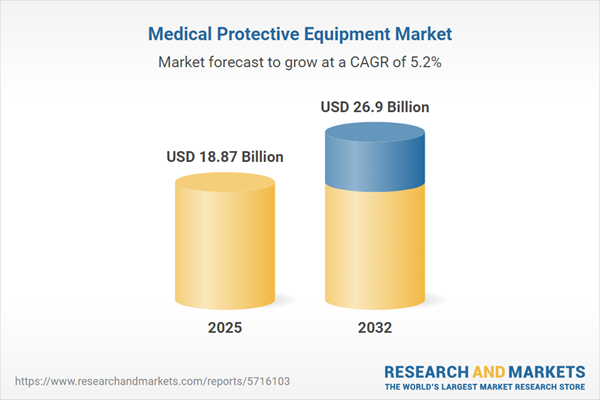Speak directly to the analyst to clarify any post sales queries you may have.
The medical protective equipment market is evolving rapidly, creating both opportunities and challenges for organizations seeking to deliver safe, compliant, and innovative protection solutions to healthcare providers worldwide.
Market Snapshot: Medical Protective Equipment Market Size and Growth
The Medical Protective Equipment Market grew from USD 17.92 billion in 2024 to USD 18.87 billion in 2025. It is expected to continue growing at a CAGR of 5.20%, reaching USD 26.90 billion by 2032.
Scope & Segmentation
This report delivers detailed segmentation and actionable insights across the medical protective equipment market, encompassing product types, material compositions, end-user groups, channels, and sterility attributes. Coverage extends to global and regional dynamics, technological advances, and the strategies of leading industry participants.
- Product Types: Face shields (adjustable, non-adjustable), gloves (sterile, non-sterile), goggles (ventilated, non-ventilated), protective clothing (disposable, reusable), respirators (FFP2, N95), surgical masks (Type I, Type II, Type IIR).
- Material Composition: Latex, nitrile, polyethylene, polypropylene, PVC.
- End User Groups: Clinics, dental clinics, diagnostic laboratories, home care, hospitals.
- Distribution Channels: Direct sales, hospital procurement, online retail, retail pharmacies, wholesale distributors.
- Sterility Types: Sterile, non-sterile.
- Regional Markets: Americas (North and Latin America), Europe, Middle East & Africa, Asia-Pacific.
- Company Analysis: Includes insights on organizations such as 3M Company, Ansell Limited, Honeywell International Inc., Kimberly-Clark Corporation, and others.
Key Takeaways for Senior Decision-Makers
- Organizations must adapt to increasingly complex supply chains and stringent regulatory environments, ensuring robust protocols for product safety and quality.
- Technological advances—including digital twins, advanced materials, and real-time analytics—are enabling faster innovation and operational agility.
- Manufacturers are investing in distributed production hubs and strategic partnerships to reduce geopolitical risk while supporting just-in-time and stockpile inventory models.
- Sustainability mandates are driving R&D in biodegradable materials and circular economy practices, influencing procurement and competitive differentiation.
- Market segmentation by end user and distribution channel reveals shifting patterns in procurement behavior, with hospitals seeking volume efficiency and home care providers emphasizing ease of use.
- Collaborations between public and private sectors, as well as among manufacturers and logistic specialists, are essential for comprehensive risk mitigation and market access.
Impact of Tariff Changes in 2025
Recent revisions to United States tariffs have prompted many companies to recalibrate sourcing strategies and manufacturing footprints. Increased duties in specific product categories have led suppliers to explore nearshoring and renegotiation of logistics contracts. Patent holders are transferring technology to allied markets to maintain competitive advantage while minimizing cost impact. These changes highlight the need for ongoing supply chain resilience strategies and contingency planning.
Methodology & Data Sources
The report employs a robust blend of primary qualitative interviews with procurement, manufacturing, and regulatory leaders, alongside comprehensive secondary research across regulatory filings, patent databases, and industry reports. Data triangulation and analytical cross-validation ensure accuracy and reliability in every insight presented.
Medical Protective Equipment Market: Why This Report Matters
- Enables senior leaders to identify high-value growth segments and innovation pathways aligned with evolving healthcare and regulatory environments.
- Equips strategy, procurement, and R&D teams with actionable data for market entry, resilience planning, and partnership evaluation.
- Facilitates informed decision-making through in-depth regional, product, and channel analysis, supporting investment prioritization and risk management.
Conclusion
The medical protective equipment market is undergoing significant transformation, requiring organizations to align strategies with dynamic market forces and regulatory shifts. Stakeholders leveraging adaptive models, material innovation, and cross-sector collaboration will be best positioned to achieve sustainable growth and long-term competitiveness.
Additional Product Information:
- Purchase of this report includes 1 year online access with quarterly updates.
- This report can be updated on request. Please contact our Customer Experience team using the Ask a Question widget on our website.
Table of Contents
3. Executive Summary
4. Market Overview
7. Cumulative Impact of Artificial Intelligence 2025
Companies Mentioned
The companies profiled in this Medical Protective Equipment market report include:- 3M Company
- Ansell Limited
- Honeywell International Inc.
- Kimberly-Clark Corporation
- Ahlstrom-Munksjö Oyj
- Mölnlycke Health Care AB
- DuPont de Nemours, Inc.
- Medline Industries, L.P.
- Cardinal Health, Inc.
- Alpha Pro Tech, Ltd.
Table Information
| Report Attribute | Details |
|---|---|
| No. of Pages | 180 |
| Published | November 2025 |
| Forecast Period | 2025 - 2032 |
| Estimated Market Value ( USD | $ 18.87 Billion |
| Forecasted Market Value ( USD | $ 26.9 Billion |
| Compound Annual Growth Rate | 5.2% |
| Regions Covered | Global |
| No. of Companies Mentioned | 11 |









